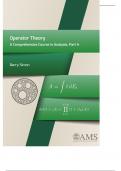Summary
Summary Operator Theory A Comprehensive Course in Analysis, Part 4 Barry Simon
- Institution
- Alabama A&M University
Reed–Simon2 starts with “Mathematics has its roots in numerology, geometry, and physics.” This puts into context the division of mathematics into algebra, geometry/topology, and analysis. There are, of course, other areas of mathematics, and a division between parts of mathematics can be ar...
[Show more]



